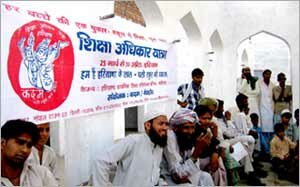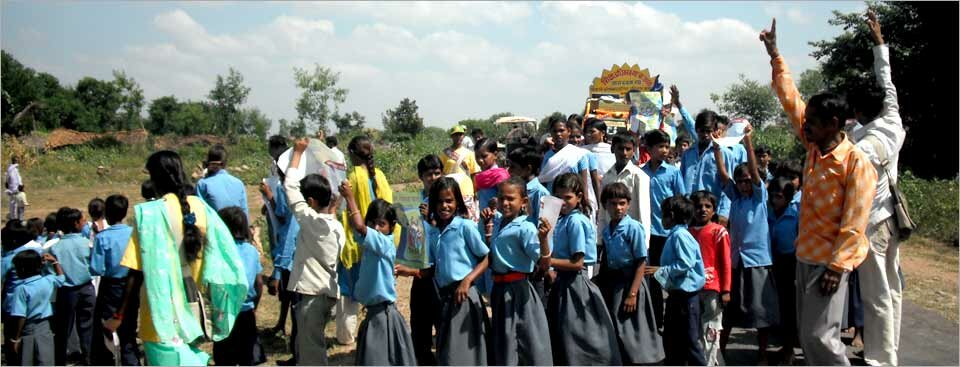Achievement of Shiksha Adhikar Yatra in Haryana
Shiksha Adhikar Yatra (SAY) succeeded tremendously. It won approval from the United Naitons Millennium Campaign. Its success was presented as a case study in a special publication by the UN Millennium Campaign brought out at the time of High Level Event on MDGs in UN General Assembly in 2008.
 The results of Shiksha Adhikar Yatra were highly encouraging. The number of children of school-going age who are not attending schools in Haryana decreased from 1,47,913 to 64,185. This impressive decline of 57% was achieved in just a few months as this programme was launched in 2007.
The results of Shiksha Adhikar Yatra were highly encouraging. The number of children of school-going age who are not attending schools in Haryana decreased from 1,47,913 to 64,185. This impressive decline of 57% was achieved in just a few months as this programme was launched in 2007.
The drive ensured that many children of migratory labour who had come to work in mining, stone crushers and rice mill areas of districts of Ambala, Karnal and Mewat got the chance to join the school. In Mewat, for example, there is a yearly addition of 30,000 to 40,000 children of school-going age every year. But most of them are either unable to go to school or drop out after attending it for a few years. Sustained awareness drives and interactions with parents, enabled the Shiksha Adhikar Yatra to put them back in school.
SAY – Uttar Pradesh, Rajasthan and Madhya Pradesh
Centre for Alternative Dalit Media in collaboration with United Nations carried out Shiksha Adhikar Yatra (SAY) in more than 100 villages of Lalitpur, Jhansi (UP) and Udaipur, Chittoregarh (Rajasthan) from August 31 to October 6, 2009 with the active support and participation of Janchetna Sansthan (Udaipur), Navachar Sansthan (Chittor) and Bundelkhand Dalit Adhikar Manch (UP). This Shiksha Adhikar Yatra was part of the country study conducted by the UN and its agencies.
Like previous Shiksha Adhikar Yatras, this was also a physical entourage of educational awareness with a team (comprising of 15-20 persons) of educated, trained, dedicated and committed social leaders that motivated people for educational attainments. Shiksha Adhikar Yatra teams were trained to generate interests of both literate and illiterate in understanding their rights and obligations for achieving sustainable universal elementary education. The teams covered low literacy areas, rural and urban both, in all the four districts. Interactions with the people were aimed at ensuring achievement of quality elementary education for all with the participation and stake of the people.
Sikhsha Adhikar Yatra used powerful tools such as Nukkad Natak (street plays), to have visual interactive communication and have a deep lasting impact on general peoples. The Yatra also conveyed its message through wall writing, mime, skits, dialogues and discussions in public gatherings in villages. Card, Posters and Badges with SAY aims and objectives were distributed to the children. Questionnaires were also distributed during various cultural performance and collected back just after the event. The questionnaires were drafted in such a way so that it reflected the educational status, problem and involvement of VEC in education system of a village.
Shiksha Adhikar Yatra was hugely successful in addressing the following issues:
- Mobilizing community for the realisation of Educational Rights in the context of all children including socially, educationally and economically backward classes, including Muslims and other minorities.
- Creating awareness among all stake holders, Panchayats members, members of Village Education Committee (VEC), Parent Teacher Associations (PTA) about universalization of education.
- Promoting active participation of villagers, VEC and PTA members in the planning, implementing and monitoring and evaluation process of education of a village.
- Promoting girls’ education.
- Strengthening of Local Community Based Organizations, Panchayats and Parent-Teacher groups, Village Education Committee for promoting transparency and accountability.
- Helping researchers to undertake Policy Analysis and Advocacy through media and other stakeholders such as political groups, teachers’ union etc

